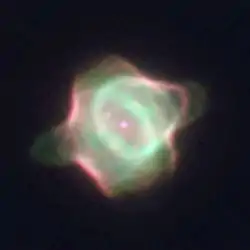Stingray Nebula
The Stingray Nebula (Hen 3-1357) is the youngest known planetary nebula (PN). (Bobrowsky 1994) The Stingray is located in the direction of the southern constellation Ara (the Altar), and is located 18,000 light-years away. Although it is some 130 times the size of the Solar System, the Stingray Nebula is only about 1/10 the size of most other known planetary nebulae. Until approximately forty years ago, it was observed on Earth as a protoplanetary nebula in which the gas had not yet become hot and ionized. In a Nature article, Bobrowsky et al.[3] described how the Hubble observations revealed a 17th-magnitude companion to the Stingray's 15th-magnitude central star. The image of the Stingray Nebula shown here shows how the outer shells of gas are collimating the continuing outflow of gas from the central star—an important observation, as the process of how these outflows become collimated has not been well understood.
| Emission nebula | |
|---|---|
| Planetary nebula | |
 Hubble Space Telescope photograph of the nebula (Credit: M. Bobrowsky and NASA) | |
| Observation data: J2000 epoch | |
| Right ascension | 17h 16m 21.071s[1] |
| Declination | −59° 29′ 23.64″[1] |
| Distance | 18 kly (5.6 kpc)[2] ly |
| Apparent magnitude (V) | 10.75[1] |
| Apparent dimensions (V) | 1″.6[2] |
| Constellation | Ara |
| Physical characteristics | |
| Radius | 0.08[2] ly |
| Absolute magnitude (V) | -3.0[a] |
| Designations | PN G331.3-12.1,[1] Hen 3-1357[1] |
History
Prior to the discovery of the nebula, the central star of the Stingray Nebula was known as He3-1357, which Karl Gordon Henize classified as an A or B type Hα emission line star in 1967. It was observed in 1971 to be a pre-planetary nebula (PPNe) when it seemed to be an asymptotic giant branch (AGB) B1 supergiant. Planetary nebula (PN) emission lines were identified in this star in 1989 by the IUE (Parthasarathy et al. 1993).[4] As the nebula would be newly formed and very small, ground-based observations were not able to resolve it; so Bobrowsky[2] observed it with the Hubble Space Telescope, discovering the nebula, which he named the "Stingray Nebula."
In January of 2021 NASA discovered that the nebula is fading.[5] In a NASA statement a team member, Martín A. Guerrero of the Instituto de Astrofísica de Andalucía in Granada, Spain, said "“This is very, very dramatic, and very weird,” going on to say “What we’re witnessing is a nebula’s evolution in real time. In a span of years, we see variations in the nebula. We have not seen that before with the clarity we get with this view.”[6]
Planetary nebula nucleus
In 1995 the central planetary nebula nucleus (PNN) was observed as a DA white dwarf, having seemingly faded by a factor of three between 1987 and 1995. The PNN has an estimated mass of 0.6 M☉, and has an observed companion star separated by 0.3 arcsec. Nebula mass is estimated as 0.015 M☉.
Luminosity is estimated to be 3000 L☉. (Parthasarathy 2000)
The central star is unusual in that it has brightened and faded over a period of 20 years. Its temperature went up by 40,000°C. An explanation for this is that it has undergone a helium flash.[7]
Gallery
 Fast evolving star SAO 244567 is located in the center of the Stingray nebula.[8]
Fast evolving star SAO 244567 is located in the center of the Stingray nebula.[8]
Notes
- ^ 10.75 apparent magnitude - 5 * (log10(5.6 kpc distance) - 1) = -3.0 absolute magnitude
- SIMBAD 2007
- Bobrowsky 1994
- Bobrowsky et al. 1998
- Parthasarathy 2000
- January 2021, Samantha Mathewson 08. "The Stingray nebula is fading fast, Hubble telescope photos reveal". Space.com. Retrieved 2021-01-08.
- Jenner, Lynn (2020-11-30). "Hubble Captures Unprecedented Fading of Stingray Nebula". NASA. Retrieved 2021-01-08.
- "Astronomers observe star reborn in a flash". PhysOrg. 13 September 2016. Retrieved 18 September 2016.
- "Stingray Nebula and SAO 244567". www.spacetelescope.org. Retrieved 15 September 2016.
References
- Parthasarathy, M. (2000), "Birth and early evolution of planetary nebulae", Bulletin of the Astronomical Society of India, 28: 217–224, Bibcode:2000BASI...28..217P
- Bobrowsky, Matthew (1994), "Narrowband HST Imagery of the Young Planetary Nebula Henize 1357", The Astrophysical Journal, 426: L47–L50, Bibcode:1994ApJ...426L..47B, doi:10.1086/187336
- Bobrowsky, Matthew; Sahu, Kailash C.; Parthasarathy, M.; García-Lario, Pedro (1998), "Birth and early evolution of a planetary nebula", Nature, 392 (6675): 469–471, arXiv:astro-ph/9804022, Bibcode:1998Natur.392..469B, doi:10.1038/33092
- SIMBAD (January 15, 2007), Results for Stingray Nebula, SIMBAD, Centre de Données Astronomiques de Strasbourg
External links
 Media related to Stingray Nebula at Wikimedia Commons
Media related to Stingray Nebula at Wikimedia Commons- The Scale of the Universe (Astronomy Picture of the Day 2012 March 12)
- Stingray Nebula at Constellation Guide